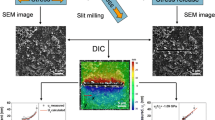Abstract
In this study a new residual stress determination method in two directions simultaneously is presented. This method is based on stresses relaxation in a groove that is machined incrementally. The residual stresses relaxation occurs simultaneously from both the depth and the length of the groove. Thus, measuring the surface strain field generated by the relaxation enables to determine the stress gradient both along the depth and the length of the groove. To measure the surface strain in a direction perpendicular to the groove, a digital speckle pattern interferometer is used. This method is suitable when the residual stress field in the structure varies in the depth as well as along the surface of the part, like for example in a welded structure. The method is tested here on an aluminium plate in which a central band has been shot peened.













Similar content being viewed by others
References
Lu J (1996) Handbook of measurements of residual stress. SEM, Edited by Jian Lu
Lu J (2005) Handbook on residual stresses. Second edition, Volume 1 Residual stress: manufacturing and materials processing. Volume 2. Residual stress and mechanical design. SEM, edited by Jian Lu
Hauk V (1997) Structural and residual stress analysis by non destructive methods. Elsvier
Hathaway RB, Hovanesian JD, Hung MYY (1997) Residual stress evaluation using shearography with large-shear displacements. Opt Lasers Eng 271:43–60.
Montay G, Bulhak J, Surrel Y, Vautrin A, Lu J (2005) Use of full field of strains found by grating shearography to determine residual stress. J Strain Anal Eng Des 407:621–630.
Schajer GS, Steinzig M (2005) Full-field calculation of hole drilling residual stresses from electronic speckle pattern interferometry data. Exp Mech 456:526–532.
Wu Z, Lu J, Han B (1998) Study of residual stress distribution by a combined method of Moire interferometry and incremental hole drilling, Part I: Theory. J Appl Mech-Trans ASME 654:837–843.
Wu Z, Lu J, Han B (1998) Study of residual stress distribution by a combined method of Moire interferometry and incremental hole drilling, part II: implementation. J Appl Mech-Trans ASME 654:844–850.
Ya M, Marquette P, Belahcene F, Lu J (2004) Residual stresses in laser welded aluminium plate by use of ultrasonic and optical methods. Mater Sci Eng, A Struct Mater Prop Microstruct Process 3821–2:257–264.
Duquennoy M, Ouaftouh M, Qian ML, Jenot F, Ourak M (2001) Ultrasonic characterization of residual stresses in steel rods using a laser line source and piezoelectric transducers. NDT E Int 345:355–362.
Montay G, Cherouat A, Lu J, Baradel N, Bianchi L (2002) Development of high precision incremental step hole drilling method for the study of residual stress in multi-layer materials: influence of temperature and substrate on ZrO2–Y2O3 8 wt.% coating. Surf Coat Technol 155155/2–3:152–160.
Makino A, Nelson DV (1994) Residual stress determination by single-axis holographic interferometry and hole drilling method. Exp Mech 341:66–78.
Prime MB, Sebring RJ, Edwards JM, Hughes DJ, Webster PJ (2004) Laser surface-contouring and spline data-smoothing for residual stress measurement. Exp Mech 442:176–184.
Prime MB (2006) Erratum to “laser surface-contouring and spline data-smoothing for residual stress measurement. Exp Mech 445:541.
Prime MB (2001) Cross-sectional mapping of residual stresses by measuring the surface contour after a cut. J Eng Mater Technol 1232:162–168.
Hill MR, Lin WY (2002) Residual stress measurement in a ceramic-metallic graded material. J Eng Mater Technol-Trans ASME 1242:185–191.
Schajer GS, Prime MB (2007) Residual stress solution extrapolation for the slitting method using equilibrium constraints. J Eng Mater Technol-Trans ASME 1292:227–232.
Cloud G (1995) Optical methods of engineering analysis. Cambridge University Press, New York.
Jones R, Wykes C (1989) Holographic and speckle interferometry. 2nd edn. Cambridge University Press
Nicoletto G (1991) Moire interferometry determination of residual stresses in the presence of gradients. Exp Mech 313:252–256.
Kaufmann GH, Galizzi GE (2002) Phase measurement in temporal speckle pattern interferometry: comparison between the phase-shifting and the Fourier transform methods. Appl Opt 4134:7254–7263.
Author information
Authors and Affiliations
Corresponding author
Rights and permissions
About this article
Cite this article
Montay, G., Sicot, O., Maras, A. et al. Two Dimensions Residual Stresses Analysis Through Incremental Groove Machining Combined with Electronic Speckle Pattern Interferometry. Exp Mech 49, 459–469 (2009). https://doi.org/10.1007/s11340-008-9151-3
Received:
Accepted:
Published:
Issue Date:
DOI: https://doi.org/10.1007/s11340-008-9151-3




